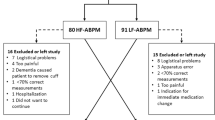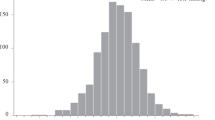Abstract
The present analysis was undertaken to evaluate postprandial (PP) changes in blood pressure (BP) assessed with ambulatory BP monitoring (ABPM) in elderly subjects with isolated systolic hypertension (ISH) on conventional measurement. A total of 530 patients (335 women and 195 men, aged 60–100 years, median 70 years) who performed an ABPM during the placebo run-in period of the Syst-Eur trial were included into the analysis. The PP changes in BP and heart rate (HR) were calculated by subtracting the mean systolic BP (SBP), diastolic BP (DBP) and HR in the 2 h preceding the main meal from the corresponding means covering the 2 h after the meal. The reproducibility of the postprandial fall in BP and heart rate (PPH) was assessed by contrasting the first and second ABPM in a subgroup of 147 patients who performed two ABPM’s during the placebo run-in period. The mean SBP and DBP decreased and reached the nadir 2 h after the main meal while HR did not change. When PPH was assessed by comparing BP in the 2 h before and after the meal, both SBP and DBP decreased significantly (respectively −6.6 mm Hg, −5.4 mm Hg; P < 0.001). in 67.6% of all patients a decrease in sbp was observed and in 24.1% it exceeded 16 mm hg. the corresponding values for dbp were 71.3% and 24.5% (dbp decreased more than 12 mm hg). a greater fall in dbp was associated with a greater decrease in hr (r = 0.20, P < 0.001), while changes in sbp and hr were not interrelated. regression analysis did not identify any significant covariate of pph. group means of pph could be reproduced without significant changes in their values, but the within-subject reproducibility of the pp changes was low. there were no differences in pph according to the place of residence of the patients. in conclusion, the descriptive analysis of the meal-induced changes in abpm in elderly subjects with ish showed that in every day circumstances most of them experience falls in both sbp and dbp within 2 h after the meal.
This is a preview of subscription content, access via your institution
Access options
Subscribe to this journal
Receive 12 digital issues and online access to articles
$119.00 per year
only $9.92 per issue
Buy this article
- Purchase on Springer Link
- Instant access to full article PDF
Prices may be subject to local taxes which are calculated during checkout
Similar content being viewed by others
Author information
Authors and Affiliations
Consortia
Rights and permissions
About this article
Cite this article
Grodzicki, T., Rajzer, M., Fagard, R. et al. Ambulatory blood pressure monitoring and postprandial hypotension in elderly patients with isolated systolic hypertension. J Hum Hypertens 12, 161–165 (1998). https://doi.org/10.1038/sj.jhh.1000573
Received:
Accepted:
Published:
Issue Date:
DOI: https://doi.org/10.1038/sj.jhh.1000573



